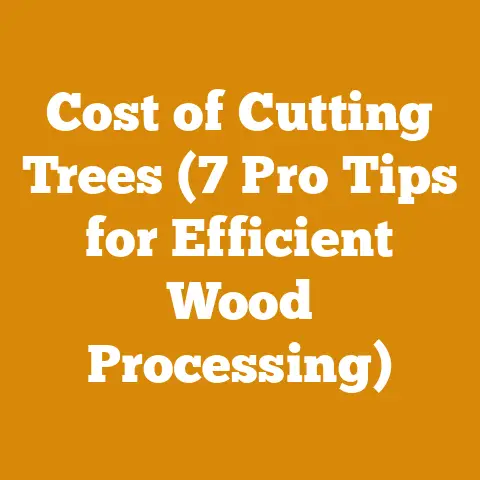Wood Chipper vs Shredder (5 Pro Tips for Efficient Wood Processing)
As someone who’s spent years knee-deep in sawdust and the satisfying roar of engines processing wood, I understand the financial considerations intimately. Let’s dive into how to make the right call, keeping your wallet and your sanity intact.
Budgeting for Wood Processing: A Personalized Approach
Before we even discuss the nitty-gritty of wood chippers and shredders, let’s talk about money. I’ve learned that a clear budget is the cornerstone of any successful wood processing project. Whether you’re a homeowner tidying up your yard or a small-scale logger preparing firewood, understanding your financial limits upfront will save you headaches down the road.
Budget Options – Finding Your Sweet Spot
- The Minimalist (Under $300): If you’re on a tight budget and only have occasional light-duty needs, consider a small electric shredder. These are generally less powerful but can handle leaves, small twigs, and soft plant materials. You’re looking at a trade-off between price and performance.
- The Weekend Warrior ($300 – $700): This range opens up options for electric wood chippers and more robust shredders. These can handle branches up to a couple of inches in diameter and are suitable for homeowners with moderate yard maintenance needs.
- The Serious DIYer ($700 – $2,000): This is where you start to see gas-powered chipper shredders enter the picture. They offer more power, portability, and the ability to handle larger branches (up to 3-4 inches). Expect to pay more for fuel, maintenance, and potentially repairs.
- The Professional ($2,000+): For those with significant wood processing needs, such as small-scale logging or firewood businesses, a commercial-grade wood chipper is essential. These machines are powerful, durable, and can handle large volumes of wood. They also come with a hefty price tag and require specialized maintenance.
My Personal Experience
I remember when I first started processing firewood, I tried to get away with using a cheap electric shredder to deal with the smaller branches. It was a disaster! The machine constantly jammed, and it took forever to process even a small pile of debris. I quickly realized that investing in a quality gas-powered chipper shredder was a necessity, not a luxury. It saved me countless hours of frustration and ultimately paid for itself in increased efficiency.
Understanding the Key Differences: Wood Chipper vs. Shredder
To make the right choice, it’s crucial to understand the fundamental differences between these two machines.
Wood Chippers: Power and Efficiency for Branches
Wood chippers are designed to reduce branches and limbs into small, uniform chips. They typically use blades or knives that rotate at high speeds to chop the wood.
- Ideal Use: Processing branches, limbs, and woody materials.
- Output: Uniform wood chips suitable for mulch, landscaping, or composting.
- Mechanism: Rotating blades or knives.
- Capacity: Typically handles branches from 1 inch to 7 inches in diameter, depending on the model.
- Cost: Ranging from $200 for small electric models to $20,000+ for commercial-grade machines.
Shredders: Versatility for Yard Waste
Shredders are more versatile machines designed to process a wider range of materials, including leaves, twigs, and soft plant debris. They often use hammers, flails, or rotating lines to break down the material.
- Ideal Use: Processing leaves, twigs, garden waste, and soft plant materials.
- Output: Less uniform material, often used for composting or as a soil amendment.
- Mechanism: Hammers, flails, or rotating lines.
- Capacity: Handles smaller branches and softer materials.
- Cost: Ranging from $100 for small electric models to $1,000+ for more robust gas-powered units.
5 Pro Tips for Efficient Wood Processing
Now, let’s get into the meat of the matter: how to choose the right machine and use it effectively to maximize your wood processing efficiency.
Tip 1: Match the Machine to the Material
This might seem obvious, but it’s a critical mistake I see people make all the time. Don’t try to force a shredder to do a chipper’s job, or vice versa.
- Branches and Limbs: If your primary task is processing branches and limbs, a wood chipper is the clear choice. The blades are designed to efficiently cut through woody material, producing uniform chips.
- Leaves and Soft Debris: For processing leaves, twigs, and garden waste, a shredder is the better option. The hammers or flails will break down the material into smaller pieces, making it ideal for composting.
- Combined Needs: If you have a mix of materials to process, consider a chipper shredder. These machines combine the functions of both a chipper and a shredder, offering versatility for different types of yard waste.
Data Point: According to a survey by the National Gardening Association, the average homeowner spends approximately \$150 per year on mulch. By chipping your own branches, you can significantly reduce this expense.
Tip 2: Power Up: Electric vs. Gas
The choice between electric and gas-powered machines depends on your needs and budget.
- Electric: Electric chippers and shredders are typically less expensive, quieter, and require less maintenance than their gas-powered counterparts. They are ideal for homeowners with small yards and light-duty needs. However, they are limited by their power cord and may not be suitable for processing large branches or thick materials.
- Gas: Gas-powered chippers and shredders offer more power and portability than electric models. They are suitable for larger properties and can handle thicker branches and tougher materials. However, they are more expensive, require more maintenance, and produce emissions.
Cost Breakdown:
| Feature | Electric Chipper Shredder | Gas Chipper Shredder |
|---|---|---|
| Purchase Price | \$200 – \$700 | \$700 – \$2,000+ |
| Fuel/Electricity | Low | Moderate to High |
| Maintenance | Low | Moderate |
| Noise Level | Low | High |
| Portability | Limited | High |
| Processing Power | Low to Moderate | Moderate to High |
My Insight: I’ve found that gas-powered chipper shredders are a better long-term investment for anyone who regularly processes wood. The extra power and portability are worth the added cost, especially if you have a large property or need to move the machine around.
Tip 3: Safety First: Gear Up and Know the Rules
Wood chippers and shredders are powerful machines that can cause serious injury if not used properly. Always wear appropriate safety gear, including:
- Safety Glasses: Protect your eyes from flying debris.
- Hearing Protection: Wood chippers and shredders can be very loud.
- Gloves: Protect your hands from splinters and cuts.
- Long Sleeves and Pants: Prevent skin abrasions.
- Sturdy Shoes: Protect your feet from falling debris.
Safety Checklist:
- Read the owner’s manual carefully before using the machine.
- Keep children and pets away from the work area.
- Never reach into the machine while it is running.
- Use a push stick to feed materials into the machine.
- Inspect the machine regularly for damage and wear.
- Turn off the machine and disconnect the power source before performing any maintenance.
Idiom Alert: An ounce of prevention is worth a pound of cure. Taking the time to prioritize safety will save you from potential accidents and injuries.
Tip 4: Maintenance Matters: Keep Your Machine Running Smoothly
Regular maintenance is essential for keeping your wood chipper or shredder running smoothly and extending its lifespan.
- Clean the Machine: Remove debris and buildup after each use.
- Sharpen Blades: Keep the blades sharp for efficient cutting.
- Check Oil Levels: Maintain proper oil levels in gas-powered machines.
- Replace Air Filters: Keep the air filter clean for optimal engine performance.
- Lubricate Moving Parts: Grease moving parts to reduce friction and wear.
- Store Properly: Store the machine in a dry, protected area when not in use.
Cost of Maintenance:
- Electric: Minimal maintenance, primarily cleaning and occasional blade sharpening.
- Gas: Requires regular oil changes, air filter replacements, spark plug replacements, and blade sharpening.
Personal Story: I once neglected to change the oil in my gas-powered chipper shredder, and it ended up seizing the engine. The repair cost me hundreds of dollars and a lot of downtime. Learn from my mistake – regular maintenance is worth the effort!
Tip 5: Optimize Your Output: Composting and Mulching
Wood chips and shredded material can be valuable resources for your garden or landscape.
- Composting: Shredded leaves and twigs are excellent additions to a compost pile. They provide carbon, which is essential for the composting process.
- Mulching: Wood chips can be used as mulch around trees and shrubs. They help to retain moisture, suppress weeds, and regulate soil temperature.
- Soil Amendment: Shredded material can be added to the soil to improve its structure and fertility.
Data Point: According to the U.S. Environmental Protection Agency (EPA), yard waste accounts for approximately 13% of the municipal solid waste stream. By composting or mulching your yard waste, you can reduce your environmental impact and create valuable resources for your garden.
Practical Example: I use wood chips from my chipper to mulch around my fruit trees. It helps to keep the weeds down, retain moisture, and enrich the soil. I’ve noticed a significant improvement in the health and productivity of my trees since I started using wood chip mulch.
Real-World Cost Analysis and Budgeting Examples
Let’s break down some specific cost scenarios to illustrate how to budget for wood processing projects.
Scenario 1: Homeowner with Small Yard
- Project: Clearing small branches and leaves from a residential yard.
- Equipment: Electric shredder (\$200 – \$400).
- Labor: DIY (minimal cost).
- Disposal: Composting or mulching on-site.
- Estimated Cost: \$200 – \$400.
Scenario 2: Rural Landowner Clearing Brush
- Project: Clearing brush and small trees from a larger property.
- Equipment: Gas-powered chipper shredder (\$700 – \$1,500).
- Labor: DIY (moderate cost for time).
- Disposal: Wood chips used for pathways and erosion control.
- Estimated Cost: \$700 – \$1,500.
Scenario 3: Small-Scale Firewood Business
- Project: Processing firewood from harvested trees.
- Equipment: Commercial-grade wood chipper (\$5,000 – \$20,000+), chainsaw, log splitter.
- Labor: Paid labor (significant cost).
- Disposal: Wood chips sold as mulch or used for heating.
- Estimated Cost: Varies widely depending on scale and equipment. A detailed business plan is essential.
Cost Optimization Tips:
- Rent Equipment: If you only need a wood chipper or shredder occasionally, consider renting instead of buying.
- Buy Used Equipment: Save money by purchasing used equipment in good condition.
- DIY Labor: Reduce labor costs by doing the work yourself.
- Utilize Resources: Take advantage of free resources such as wood chips from local tree services.
- Negotiate Prices: Don’t be afraid to negotiate prices with suppliers and contractors.
Global Considerations: Timber Prices and Fuelwood Markets
It’s important to consider the global context when budgeting for wood processing projects. Timber prices and fuelwood market rates can vary significantly depending on location, species, and demand.
Timber Prices:
- Softwood lumber prices have fluctuated significantly in recent years due to supply chain disruptions and increased demand for housing.
- Hardwood lumber prices are generally more stable but can vary depending on the species and grade.
- Global timber prices are influenced by factors such as deforestation, climate change, and government policies.
Fuelwood Markets:
- Fuelwood is a significant source of energy for many households around the world, particularly in developing countries.
- Fuelwood prices vary depending on the availability of wood, transportation costs, and local regulations.
- Sustainable fuelwood harvesting practices are essential for protecting forests and ensuring a reliable supply of wood.
Data Point: According to the Food and Agriculture Organization of the United Nations (FAO), approximately 2.4 billion people worldwide rely on fuelwood for cooking and heating.
Calculations and Formulas for Wood Processing
Here are some useful calculations and formulas for estimating wood volume and drying time.
Calculating Volume of Logs
-
Board Feet: A board foot is a unit of volume equal to 144 cubic inches (12 inches x 12 inches x 1 inch). The formula for calculating board feet in a log is:
(Diameter in inches)^2 x Length in feet / 16* Cords: A cord is a unit of volume equal to 128 cubic feet (4 feet x 4 feet x 8 feet). The formula for estimating the number of cords in a pile of logs is:(Length in feet x Width in feet x Height in feet) / 128
Estimating Drying Time
- Moisture Content: The moisture content of wood is the percentage of water in the wood.
- Drying Time: The drying time for firewood depends on factors such as wood species, climate, and stacking method. A general rule of thumb is that firewood needs to dry for at least 6-12 months to reach a moisture content of 20% or less.
Formula for Estimating Drying Time:
Drying Time (months) = K x (Initial Moisture Content - Target Moisture Content)
Where K is a constant that varies depending on the climate and wood species.
Actionable Takeaways and Next Steps
- Assess Your Needs: Determine the type and volume of materials you need to process.
- Set a Budget: Establish a clear budget for equipment, labor, and disposal.
- Choose the Right Machine: Select a wood chipper or shredder that matches your needs and budget.
- Prioritize Safety: Always wear appropriate safety gear and follow safety guidelines.
- Maintain Your Equipment: Keep your machine running smoothly with regular maintenance.
- Utilize Your Output: Compost or mulch your yard waste to create valuable resources.
Final Thoughts: Wood processing can be a rewarding and cost-effective way to manage yard waste and prepare materials for your garden or landscape. By following these tips and budgeting carefully, you can maximize your efficiency and minimize your expenses. So, get out there, gear up, and start processing! Don’t be afraid to get your hands dirty – it’s all part of the fun.






